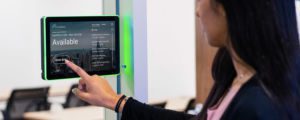A hybrid workplace, driven by hybrid workplace technology, is a strategy that mixes traditional in-office work with remote work options, offering more flexibility to employees. Flexibility is more important than ever in this historically tight labor market. The most recent Future Forum Pulse quarterly survey of more than 10,000 employees in the U.S., Australia, France, Germany, the U.K. and Japan showed. Not being open to hybrid workforce models can hurt your organization’s employee retention and productivity.
In a recent webcast, Dan Lorenz of AMS Workplace Technology discussed hybrid workplace optimization strategies and technologies with Ibrahim Yate of Verdantix. AMS has been a FM:Systems Certified Business Partner for 20 years and specializes in integrated digital workspace management systems for organizations in financial services, pharmaceuticals, research and higher education. Verdantix is an independent market research firm focused on technology applications and markets involving ESG and smart buildings. Dan and Ibrahim presented five technologies that can support hybrid workplace models and help companies deliver a winning employee experience.

Transition Challenges in Hybrid Workplace Technology Implementation
Adopting a hybrid workplace model involves overcoming some challenges. It is a big transition and the traditional office model wasn’t properly equipped to accommodate this much flexibility when the pandemic began. Two and a half years later, most organizations have made much headway in accommodating hybrid and remote work. But space planners and facilities managers may find their existing real estate portfolio, planning tools, and management processes out of alignment with their future needs for the hybrid workplace.
Areas of misalignment in hybrid workplace technology may include:
- Planning for number and types of spaces—having enough collaborative rooms and correct spacing/ratio for workstations
- Seating assignment—adopting a system to reserve unassigned seating on demand
- Visitor management—touchless experience and the ability to track health requirements
- Employee communication—having a good way to gather opinions and feedback
As companies discover these areas of misalignment, many will need to gather more data and adjust their plan for hybrid workplaces. Just this week, Amazon announced a pause in construction on six office towers in Bellevue, WA and Nashville, Tn so they company can reevaluate needs and floor plans in light of its hybrid work model.

Making a New Plan with Hybrid Workplace Technology
Organizations are reevaluating the size of their real estate portfolios and the design of floor plans and workspaces. Going forward, some will look toward downsizing to match lower average daily occupancy rates common with a hybrid workforce model. Verdantix research revealed more than half of companies were accelerating the use of flexible offices/satellite hubs as options for low commitment real estate leases that can be discarded quickly if circumstances change.
The most important aspect of your hybrid workplace strategy model is that it is tailored to your organization’s unique needs and future goals. There is no one right or wrong plan for moving forward. The hybrid workplace model is not a one-size-fits-all approach. Moreover, successful organizations will build feedback mechanisms into their workplace management plans so they can remain adaptive to a changing business environment.

Do You Have the Right Tools for Hybrid Workplace Optimization Technology?
Technology will play a big role in helping businesses achieve their goals as they lean into new hybrid workplace optimization strategies. As you can see in the chart below, technology can assist in planning and forecasting through execution and the employee experience.

Here are five tools that help organizations more effectively plan and execute solid hybrid workplace strategies:
- Integrated Workplace Management System (IWMS) – How can you make a plan if you don’t have the tools to view and analyze data about your space and people? An IWMS centralizes all workspace management data for better analysis and decision-making. The system enables an organization to manage and report on their entire space inventory. You can visualize departmental space allocations and seating assignments. An IWMS also makes it easier to game out What-If scenarios and see the impacts of potential floor plan redesigns, changes to collaborative spaces or workstations, and/or changes to neighborhood seating plans. Unlike AutoCAD or Excel, an IWMS delivers real-time spatial and summary reporting through graphical floor plans, including the ability to drag and drop changes to floor plans. It also helps planners forecast both staffing changes (job requisitions) and changes to space needs (personas).
- Workplace Desk and Room Booking – When employees need to come into the office, it should be easy for them to quickly find an available workspace and reserve it. Employees need to be able to see where teammates are working and locate next to them. They need to be able to select the right type of meeting room for onsite or hybrid groups to meet. Booking should be quick and convenient, and offer a touchless self-service experience. Mobile apps and the company email system are great options. The Verdantix survey showed 81% of space executives thought it was ‘important or very important’ to offer room and space booking capability in workplace mobile apps.
- Visitor Management System – How can you incorporate new policies for visitors while still ensuring a streamlined visitor management process? Many organizations now have some (mostly) fully remote employees whose experience during rare visits to the office will be more like a visitor than an employee. Visitor management technology can help you more easily pre-register individuals and groups, both before visits and on-site. Again, with the support of a mobile app, you can make the experience convenient and touchless. Visitors can learn about any health policies and procedures such as vaccination and mask requirements ahead of their visit. You should be able to print badges and integrate with any desk booking or wayfinding capabilities.
- Mobile Employee Concierge – This mobile employee experience app should help employees become more empowered within the hybrid workplace. It’s a one-stop-shop of information and services employees need. Push notifications can make announcements to employees and highlight special events, food service announcements and more. Employees should be able to see which colleagues are in the building. These apps can also provide auxiliary information and services—examples include helping employees request an Uber, fill out a work order, find traffic updates or order food.
- Occupancy Sensors – People move around. They utilize spaces in unanticipated ways. Without access to indisputable data for informed decision-making, you cannot know what is truly happening in the workplace. Occupancy sensors enable you to see, in real-time, how many people are using a space. This can help you ascertain how many employees are coming to the office and on what days. You’ll know with certainty where people tend to work (and where they do not) and how long they tend to use different spaces. You can see what types of spaces get used the most. All of this information will help you adjust and adapt your data-driven hybrid workplace plan.
For more hybrid workplace technology insights, watch the complete on-demand webcast, Five Technologies that Can Optimize the Hybrid Workplace Experience. You will learn more about trends about how organizations are leveraging technology to enhance the hybrid workplace experience. Dan and Ibrahim also examined use cases from three different industries to demonstrate how different companies are moving forward with hybrid workplace models.
Learn more about how to leverage technology for a better hybrid model and employee experience, watch our on-demand panel discussion.
Frequently Asked Questions:
-
What are the 5 C’s of hybrid work?
- The 5 C’s of hybrid work are Communication, Collaboration, Culture, Connectivity, and Continuity. These elements are essential for creating an environment where both remote and in-office employees can thrive, ensuring that all team members remain connected, engaged, and aligned with organizational goals, regardless of where they are working from.
-
What is an example of a hybrid workplace?
- A typical example of a hybrid workplace is a 3/2 work schedule. In this arrangement, employees are expected to work from the office three days a week and have the flexibility to work remotely for the remaining two days. This model supports a balanced approach, combining the structure and social interaction of in-office work with the flexibility and autonomy of remote work.










